Reptiles and Amphibians
Media
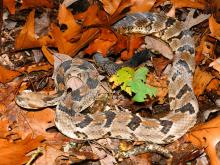
Species Types
Scientific Name
Crotalus horridus
Description
Missouri’s largest venomous snake, the timber rattlesnake, is dangerously venomous, but there are few cases of rattlesnake bites in our state. It frequents rough country, is mostly nocturnal in summer, and few Missourians ever encounter it.
Media
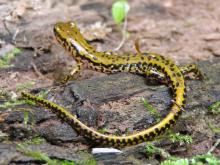
Species Types
Scientific Name
Eurycea longicauda longicauda (eastern dark-sided salamander) and E. l. melanopleura (dark-sided salamander)
Description
The eastern long-tailed salamander and closely related dark-sided salamander are agile and can escape predators by using their tails for quick jumps. They live in the southern and eastern parts of Missouri.
Media

Species Types
Scientific Name
Coluber constrictor flaviventris (eastern yellow-bellied racer) and Coluber constrictor priapus (southern black racer)
Description
The eastern yellow-bellied racer is uniformly tan, brown, olive, blue, gray, or nearly black on top, with a yellow, cream, or light blue-gray belly. It occurs nearly statewide. The southern black racer subspecies also lives in the southeastern half of the state.
Media

Species Types
Scientific Name
Anaxyrus woodhousii woodhousii
Description
The Rocky Mountain toad has a number of irregular dark brown or black spots on the back and a white belly. It occurs in the Missouri River floodplain, mostly from the central to the far northwestern parts of the state.
Media
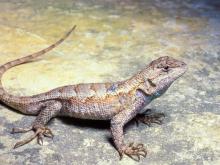
Species Types
Scientific Name
Sceloporus consobrinus
Description
The prairie lizard is a small, gray to brown, rough-scaled lizard common in open forests. It often lives around country homes and rock gardens and on stacks of firewood and split rail fences.
Media
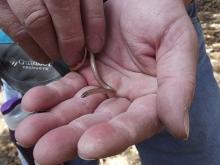
Species Types
Scientific Name
Tantilla gracilis
Description
The flat-headed snake is Missouri's smallest snake. It is found in the southern half of the state except the far southeastern corner.
Media
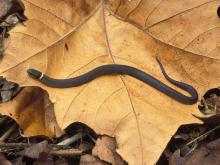
Species Types
Scientific Name
Diadophis punctatus arnyi
Description
Prairie ring-necked snakes are easily recognizable by their small size, uniform dark color on the back, bright yellow-orange belly, and distinct yellow ring around the neck. Secretive, but common nearly statewide.
Media
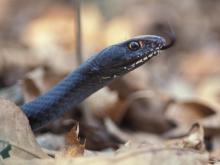
Species Types
Scientific Name
Coluber flagellum flagellum
Description
The eastern coachwhip is a long, slender, nonvenomous snake that usually escapes in an explosive burst of speed. In Missouri, it occurs in the Ozark and Ozark border regions.
Media

Species Types
Scientific Name
Plestiodon fasciatus
Description
The common five-lined skink is one of Missouri's most abundant skinks. Adults are olive or tan with lengthwise stripes. It is often called the blue-tailed skink for the coloration of juveniles. Occurs nearly statewide.
Media

Species Types
Scientific Name
Plestiodon laticeps
Description
The broad-headed skink is a large, smooth-scaled lizard that lives in the southern two-thirds of Missouri. It is frequently confused with the common five-lined skink, which is smaller.
See Also
About Reptiles and Amphibians in Missouri
Missouri’s herptiles comprise 43 amphibians and 75 reptiles. Amphibians, including salamanders, toads, and frogs, are vertebrate animals that spend at least part of their life cycle in water. They usually have moist skin, lack scales or claws, and are ectothermal (cold-blooded), so they do not produce their own body heat the way birds and mammals do. Reptiles, including turtles, lizards, and snakes, are also vertebrates, and most are ectothermal, but unlike amphibians, reptiles have dry skin with scales, the ones with legs have claws, and they do not have to live part of their lives in water.





















